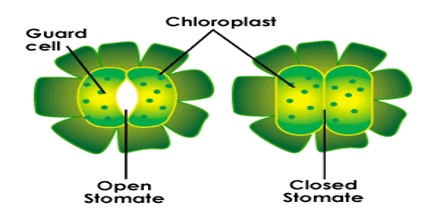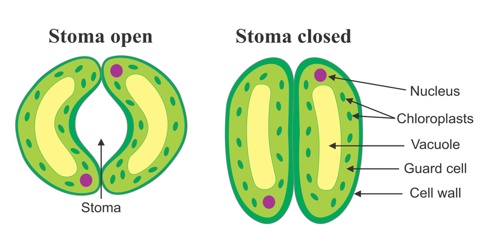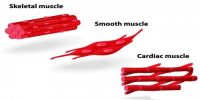Structure and Functions of stomata in Plants
Stomata are tiny openings or pores in plant tissue that allow for gas exchange. Some minute pores which are usually, found in leaf for the exchange of gas and transpiration are known as stomata. They are typically found in plant leaves and can also be found in stems and other parts of plants. Simply, when a leaf is examined under the microscope, we observe many tiny pores, which are collectively called stomata. The gas exchange that occurs when stomata are open facilitates photosynthesis. Photosynthesis is the process by which plants convert sunlight into usable energy.

Position: Stomata are present in the green part of leaf, stem, green sepals and green outer layer of glower. They are the minute openings, generally found in the epidermis of leaves. Stomata are present on the lower epidermis of dorsiventral leaves, upper and lower epidermis of isolateral leaves and partly on the floating leaves of aquatic plants. It plays a significant role by permitting the movement of gases such as oxygen, carbon dioxide, and water vapor to disperse between the interior and outer surface of the plant tissues.
Structure
- The stomatal pores are very minute and are covered with crescent-shaped guard cells. They are the tiny pores present in the epidermal surface of leaves.
- The cell wall surrounding the stoma is tough, flexible and thinner. The outer wall of guard cells is thin and the inner wall is thick. The inner wall of the guard cell towards the stomata is thicker as compared to the outer walls. Each guard cell contains cytoplasm, a nucleus and plenty of chloroplasts.
- The Guard cells are specialized, bean-shaped cells, which are found surrounding the stoma and are connected at both ends.
- The microfibrils are oriented radially rather than longitudinal. This helps stomata to open easily.
- In a dorsiventral dicotyledonous leaf, the number of stomata is greater on the lower surface as compared to the upper surface. This adaptation helps in reducing the loss of water.
- There is a single large air chamber below the stomatal pore.
Functions of stomata:
The two main functions of stomata are to allow for the uptake of carbon dioxide and to limit the loss of water due to evaporation. Stomata allow a plant to take in carbon dioxide, which is needed for photosynthesis. They also help to reduce water loss by closing when conditions are hot or dry. The gaseous exchange (CO2 and O2) between the intercellular spaces of plant cells and the outer air takes place through stomata during photosynthesis. During respiration, plants receive O2 and release CO2 through stomata.
- Stomata help in the exchange of gases i.e. uptake of carbon dioxide and release of oxygen. It helps in the exchange of gases by opening and closing the pores in the leaves.
- It helps in the transpiration i.e. the loss of water from the surface of leaves in the form of water vapor. It helps to expel the excess water out from the leaves in the form of water vapor.
- Based on the weather conditions, it closes or opens its pores to maintain the moisture balance. Loss of water from stomata creates an upward pull which helps in the absorption of water from the roots.















